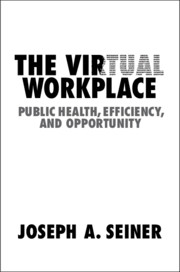33 results
3 - Pleading Standards and the Technology Sector
-
- Book:
- The Virtual Workplace
- Published online:
- 08 June 2021
- Print publication:
- 17 June 2021, pp 29-77
-
- Chapter
- Export citation
Appendix - Selected Portions of Plaintiff’s Complaint in Bradshaw v. Uber Technologies
-
- Book:
- The Virtual Workplace
- Published online:
- 08 June 2021
- Print publication:
- 17 June 2021, pp 189-192
-
- Chapter
- Export citation
6 - Harassment and the Virtual Workplace
-
- Book:
- The Virtual Workplace
- Published online:
- 08 June 2021
- Print publication:
- 17 June 2021, pp 163-184
-
- Chapter
- Export citation
Copyright page
-
- Book:
- The Virtual Workplace
- Published online:
- 08 June 2021
- Print publication:
- 17 June 2021, pp iv-iv
-
- Chapter
- Export citation
Contents
-
- Book:
- The Virtual Workplace
- Published online:
- 08 June 2021
- Print publication:
- 17 June 2021, pp vii-viii
-
- Chapter
- Export citation
Preface
-
- Book:
- The Virtual Workplace
- Published online:
- 08 June 2021
- Print publication:
- 17 June 2021, pp ix-x
-
- Chapter
- Export citation
2 - Who Is an Employee?
-
- Book:
- The Virtual Workplace
- Published online:
- 08 June 2021
- Print publication:
- 17 June 2021, pp 6-28
-
- Chapter
- Export citation
Bibliography
-
- Book:
- The Virtual Workplace
- Published online:
- 08 June 2021
- Print publication:
- 17 June 2021, pp 193-218
-
- Chapter
- Export citation
7 - A Few Final Thoughts
-
- Book:
- The Virtual Workplace
- Published online:
- 08 June 2021
- Print publication:
- 17 June 2021, pp 185-188
-
- Chapter
- Export citation
Index
-
- Book:
- The Virtual Workplace
- Published online:
- 08 June 2021
- Print publication:
- 17 June 2021, pp 219-222
-
- Chapter
- Export citation
5 - Collective Bargaining Agreements and Unions in the Modern Economy
-
- Book:
- The Virtual Workplace
- Published online:
- 08 June 2021
- Print publication:
- 17 June 2021, pp 114-162
-
- Chapter
- Export citation
4 - Aggregating Claims
-
- Book:
- The Virtual Workplace
- Published online:
- 08 June 2021
- Print publication:
- 17 June 2021, pp 78-113
-
- Chapter
- Export citation
Acknowledgments
-
- Book:
- The Virtual Workplace
- Published online:
- 08 June 2021
- Print publication:
- 17 June 2021, pp xi-xii
-
- Chapter
- Export citation
Dedication
-
- Book:
- The Virtual Workplace
- Published online:
- 08 June 2021
- Print publication:
- 17 June 2021, pp v-vi
-
- Chapter
- Export citation
1 - Introduction
-
- Book:
- The Virtual Workplace
- Published online:
- 08 June 2021
- Print publication:
- 17 June 2021, pp 1-5
-
- Chapter
- Export citation

The Virtual Workplace
- Public Health, Efficiency, and Opportunity
-
- Published online:
- 08 June 2021
- Print publication:
- 17 June 2021
Preface
-
- Book:
- The Supreme Court's New Workplace
- Published online:
- 26 July 2017
- Print publication:
- 25 July 2017, pp xiii-xvi
-
- Chapter
- Export citation
Illustrations
-
- Book:
- The Supreme Court's New Workplace
- Published online:
- 26 July 2017
- Print publication:
- 25 July 2017, pp x-ix
-
- Chapter
- Export citation
1 - The Supreme Court, Employment Discrimination, and an Overview of Civil Rights
-
- Book:
- The Supreme Court's New Workplace
- Published online:
- 26 July 2017
- Print publication:
- 25 July 2017, pp 1-18
-
- Chapter
- Export citation
Notes
-
- Book:
- The Supreme Court's New Workplace
- Published online:
- 26 July 2017
- Print publication:
- 25 July 2017, pp 169-190
-
- Chapter
- Export citation



